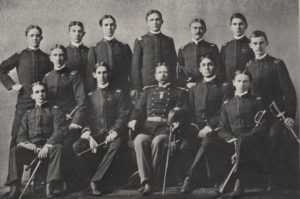
Yearbook 1905
The military program at the University of Tennessee predates that of any other land-grant university in the country. In 1844, Professor Albert Miller Lea, a West Point graduate, organized an Infantry Company, and a uniform for the cadets was adopted. This Dragoon uniform soon became quite famous. While Tennessee had been the Volunteer State since the War of 1812, when Andrew Jackson brought 1,500 volunteers intending to fight in the Battle of New Orleans (who never actually got to participate in the battle), it wasn’t until the Mexican-American War that the name really took hold. When Tennessee Governor Aaron Brown issued a call for 2,800 troops to fight in the war, 30,000 Tennesseeans volunteered, including UT’s Dragoons. Their uniform, only slightly modified, is still worn today by color guards at home football games.
In 1867, the Morrill or Land-Grant College Act was passed. Its basic purpose was to provide funds for the establishment and operation of educational institutions that would have as their primary objective the teaching of “such branches of learning as are related to agriculture and the mechanical areas…” One of the conditions laid down by the act was that institutions had to offer instruction in military tactics. In 1869, the University of Tennessee was designated Tennessee’s land-grant institution.
The National Defense Act of 1916 changed the university’s old military organization into an ROTC unit, and the national government began to pay a part of the uniform costs for basic students. Graduates of the corps were given commissions as second lieutenants in accordance with this act.
It was not until after World War II, in 1946, that Air Corps training was instituted. With the passage of the Armed Forces Unification Act in September 1947, the Air Corps ROTC began a transformation that was complete on July 11, 1949. This act changed the name of the Air Corps to the Air Force, separated it from the Army, and placed Air Force ROTC on an equal footing with Army ROTC.

Yearbook 1898 PMS Captain Brown With Cadets
As an outgrowth of policy changes in other institutions of higher learning, the University of Tennessee Senate on April 5, 1960, established a committee to examine the military science programs at the university. That committee reported to the Senate and recommended approval of a number of course changes suggested by the military. The committee also had been charged to study the question of compulsory versus voluntary programs, but it recommended that this question be held in abeyance pending action by the United States Congress on upcoming legislation on military science programs.
In 1964, following the passage of the ROTC Vitalization Act, the University Senate approved the reactivation of the committee on ROTC and AFROTC programs and requested it to complete its investigation of the question of compulsory vs. voluntary ROTC. It was the unanimous opinion of the members of the committee that a voluntary two and four-year ROTC program, in keeping with the provisions of the ROTC Vitalization Act, would afford a more efficient use of univeristy resources and facilities, attain the objective of the program as stated in the catalog, and satisfy the statutory requirement placed on the university as the state’s land-grant institution. The voluntary program went into operation in the fall of 1967. The committee further recommended that the University of Tennessee adopt such measures and policies, and provide such support and facilities, as would continue to strengthen military training on the campus in support of our national defense objectives.
In 1969, the Senate appointed another committee to examine ROTC on this campus. In keeping with the earlier resolution, the committee reported that ROTC as taught on University campuses was an acceptable alternative for preliminary professional education of students who voluntarily elected to acquire a commission in the armed forces, that ROTC had the advantages of supporting the American constitutional concept of civilian control of the armed forces, and that it provided a liberalizing education for officers entering the military from the college campus. It also recommended that the University Senate action of 1966 that made ROTC voluntary at UT should be reaffirmed to specifically emphasize the right of the student to choose whether to participate.
Today, the military science curriculum is a cooperative effort between the university, the Army, and the Air Force. Using basic guidance, the local ROTC department head (the senior military officer assigned to UT), in coordination with university officials, develops a curriculum suitable for local needs. The Army and Air Force suggest basic educational prerequisites for receiving a commission. This practice approximates that of other professional accrediting groups such as those in architecture, law, teaching, engineering, areas of business, and scientific disciplines.
The overall quality of the ROTC instructional effort at UT is at a level equivalent to that of general undergraduate education. Just as in any other program of instruction, the university has a responsibility for the supervision and maintenance of quality in ROTC studies. The ROTC Department encourages university evaluation of its activities to the same degree that is practiced for other programs, in addition to their own self-evaluation and self-study efforts. Academic credit is granted in a manner appropriate to the course content and time required.